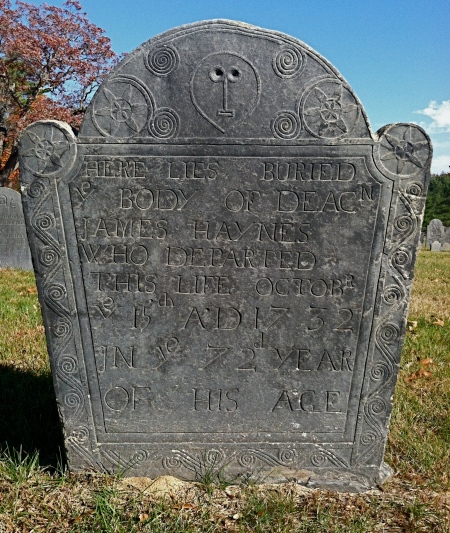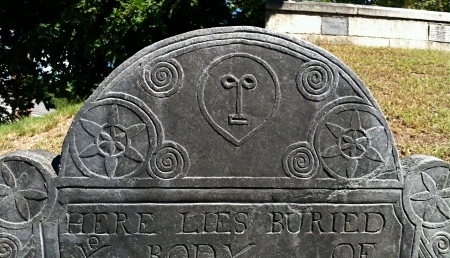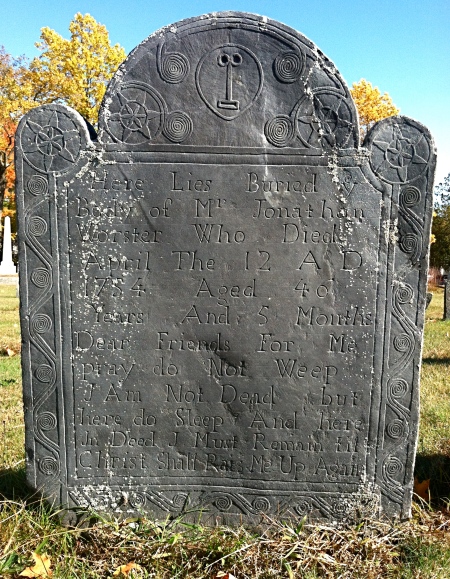Today’s essay examines the work of Jonathan Worster, active in central Massachusetts beginning in the 1720s. Most Puritan grave carvers depicted the winged death’s head, often with hourglasses, coffins, or shovels (see the prior posts, here and here). They produced recognizable variations on the same theme. Worster’s work stands apart. He created an abstract rendering of the death’s head that was unique:
Worster carved a staring visage that is neither skull nor face but rather something between. He removed the wings from the the death’s head and placed it floating on the grey plane of slate, achieving a disembodiment more powerful than the winged skulls. He frequently tapered the edges of his stone (see above), adding a sense of skyward projection. The tear-drop shape of the head itself suggests upward levitation, sometimes accentuated by off-center placement:
Worster framed his death’s head with rosettes and scrolls, suggesting stars and clouds of some celestial afterlife. The scrollwork continued along the stone’s margins. The effect is spare, primitive, and powerful. Clearly, this is authentic American artistry:
His work is also unusual for its consistency. The earliest Worster stone I’ve found is dated 1724; the last were cut in the 1750s. Throughout these decades, Worster repeated his initial design almost without variation. Was this because the effect pleased him? Had he found a pure sculptural expression which captured, for him, the grief of death and hope of resurrection? Or was this simply mercantile necessity, a successful design that he produced swiftly by avoiding alteration? We cannot answer these questions, for neither Worster nor any Puritan left meaningful commentary on the intricate monuments populating their churchyards. I hoped to find clues when I located the graves of Worster’s family. Surely, an artist would lavish special attention upon the grave of his own child:
The monument for his five-year old son is beautiful but no more intricate or polished than any of Worster’s work. Rather, he chose a somewhat smaller stone and the name was carelessly misspelled. The misspelling probably came from an apprentice—perhaps Worster’s other son, Moses—yet the decision to keep the flawed stone must have been Worster’s alone. It’s interesting that the same monument that measures his child’s life so precisely—five years, seven months, eighteen days—tolerates this error. And if we blame the misspelling upon an apprentice, it’s interesting that the grieving father did not himself chisel the inscription, as a last loving act.
Eight years following his son’s death, Jonathan Worster died:
The decorative elements of gravestones were carved first, leaving inscriptions blank until sold. Thus, Worster himself carved this stone, and the inscription was added after his death, probably by his son Moses. It’s larger than most of Worster’s work, with double rosettes and more intricate scrollwork. Yet it remains fundamentally the same design that Jonathan Worster carved for thirty years. The inscription is lengthier than most, but it shows no hint of a son’s grief, nor any mention that here is the stone of an esteemed stone-carver. There is nothing to suggest that Worster planned a special effort for his own grave.
And perhaps these facts should not surprise us. Death was a fellow traveler among the Puritans. They lacked time and emotional resources to lavish grief at the grave; they certainly lacked the physical resources to worry over spelling errors. Although they spoke of inhabiting an illuminated city upon a hill, in reality they manned an outpost in the dark wilderness. Often, their world was as opaque and inscrutable as the Worster death’s head.
All photographs taken by the author.









Fascinating collection and rendering of an artist’s family.
Very interesting post and images!
Pingback: New England Graves: Gentling the Face of Death. | An Armchair Academic
Pingback: New England Graves: A Curious Stone. | An Armchair Academic
Pingback: New England Graves: The Stone Cutter. | An Armchair Academic
I wrote from Japan.
Very interesting information. I want to know more about the artist.
Thank you. For years (since leaving Massachusetts, where I spent hours tramping through cemeteries) I have sought the name of this family of stonecarvers. An informative and thoughtful post.
Thank you for reading these essays and thank you for this note. It’s exciting when, years after writing these short articles, someone tells me that they are useful to them. You certainly may cite me in your presentation, and feel free to use my photos. If there are any of particular interest, I have a lots more pictures that I can send to you. I would be interested to see your presentation, if you can share it. My email is daviddiaz100@yahoo.com. Please let me know!